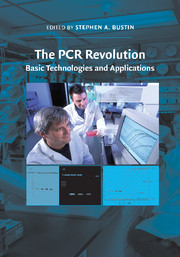Book contents
- Frontmatter
- Contents
- Contributors
- Foreword by Russell Higuchi
- Preface
- I BASIC TECHNOLOGIES
- 1 Real-time polymerase chain reaction
- 2 Thermostable enzymes used in polymerase chain reaction
- 3 Inventing molecular beacons
- 4 Rapid polymerase chain reaction and melting analysis
- 5 Polymerase chain reaction and fluorescence chemistries: deoxyribonucleic acid incarnate
- 6 Analysis of microribonucleic acid expression by quantitative real-time polymerase chain reaction
- 7 Miniaturized polymerase chain reaction for quantitative clinical diagnostics
- 8 The road from qualitative to quantitative assay: What is next?
- 9 Taking control of the polymerase chain reaction
- II APPLICATIONS
- Index
- Plate section
- References
6 - Analysis of microribonucleic acid expression by quantitative real-time polymerase chain reaction
Published online by Cambridge University Press: 25 January 2011
- Frontmatter
- Contents
- Contributors
- Foreword by Russell Higuchi
- Preface
- I BASIC TECHNOLOGIES
- 1 Real-time polymerase chain reaction
- 2 Thermostable enzymes used in polymerase chain reaction
- 3 Inventing molecular beacons
- 4 Rapid polymerase chain reaction and melting analysis
- 5 Polymerase chain reaction and fluorescence chemistries: deoxyribonucleic acid incarnate
- 6 Analysis of microribonucleic acid expression by quantitative real-time polymerase chain reaction
- 7 Miniaturized polymerase chain reaction for quantitative clinical diagnostics
- 8 The road from qualitative to quantitative assay: What is next?
- 9 Taking control of the polymerase chain reaction
- II APPLICATIONS
- Index
- Plate section
- References
Summary
Alteration of microribonucleic acid (miRNA) expression in a disease compared to a healthy state and/or correlation of miRNA expression with clinical parameters (like disease progression or therapy response) may indicate that miRNAs can serve as clinically relevant biomarkers. An important first step for further functional characterization is the information about differential miRNA expression in cellular processes such as differentiation, proliferation, or apoptosis that may determine which disease-causing genes are specifically regulated by miRNAs or, vice versa, which genes regulate miRNA expression. Whatever question you would like to address, the precise information about the level of miRNA expression in a specific cell type or tissue is often considered an important first step. A range of methods can be used for the isolation and profiling of miRNAs. Two recent reviews on microRNA and quantitative polymerase chain reaction (PCR) in European Pharmaceutical Review addressed both topics individually in great detail but not their combination. This chapter aims to provide an insight into the application of quantitative real-time PCR (qPCR) to assay microRNA expression.
miRNA EXPRESSION PROFILING USING qPCR
miRNA-specific qPCR assays are frequently used to confirm data obtained from microarray experiments but can be used independently of course. On first glance, the major advantages of this technology over microarrays are (1) the speed of the assay, (2) the increased sensitivity with which miRNAs expressed even at low levels can be measured, (3) the extended dynamic range compared to microarray analysis, and (4) the low requirement for starting material (10 ng per reaction).
- Type
- Chapter
- Information
- The PCR RevolutionBasic Technologies and Applications, pp. 80 - 87Publisher: Cambridge University PressPrint publication year: 2009



